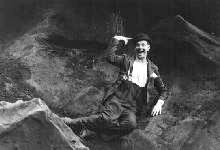SEARCH CurtainUp
REVIEWS
FEATURES
NEWS
Etcetera and
Short Term Listings
LISTINGS
Broadway
Off-Broadway
BOOKS and CDs
OTHER PLACES
Berkshires
London
LA/San Diego
Philadelphia
Elsewhere
QUOTES
On TKTS
LETTERS TO EDITOR
FILM
LINKS
MISCELANEOUS
Free Updates
Masthead
NYC Weather
Texts for Nothing
By Les Gutman

Bill Irwin
(Photo: Dixie Sheridan)
|
It's hard to imagine a more pure theatrical expression of Beckett's prose than the one engineered -- and that's a good term for it -- by Irwin. Unlike Waiting for Godot (which, written 18 months later, Irwin views as a companion piece), with these four pieces -- Nos. 1, 9, 11 and 13 from Beckett's Stories and Texts for Nothing -- the actor/clown/director is working on a clean slate: Images from Nothing, as it were. What he produces is really something.
Irwin imagines himself onto the side of a hill, another slippery slope (about which more later) but one which he has charted with precision. He is a tramp (as Anita Yavitch's costume makes clear): a mind, really, both big and small. There's nothing else to do here but ponder, so he does. His subjects have an enormous range: Is it worth the trouble of cleaning the mud off my shoes? If I hold onto life, what is it that I have my hands on?
Beckett's words demand our sharp attention; Irwin has given them his. Every tone, every pause, every inflection, is a considered one. But of course Irwin is most of all a physical magician, and his ability to express himself with (seemingly) every muscle and bone in his body is as good as it gets. From the moment he slides down from the top of Douglas Stein's rock-strewn, bepuddled hill until, some seventy-odd minutes later, he finds himself sinking into a pit from which he cannot escape, he is a mesmerizing synthesis of sight and sound.
And it's a good thing. Beckett cannot be accused of laziness, and his words are not well suited to easy listening. Irwin cannot and does not change that, but he enriches our experience with these Beckett texts markedly, without superimposing any relief on them. His performance is filled with "business" but rarely if ever does it seem extraneous.
No less an achievement is the remarkable set (nicely lit, incidentally, by Nancy Schertler). Douglas Stein has constructed his enormous hill in such a way it is not only believable -- that's real dirt and mud and rocks and water we're looking at -- but sustainable as Irwin ambles around on it night after night, depending on it to support the fierce use to which he puts it. It's an image that will be hard to forget, in a show that certainly leaves its imprint.
| TEXTS FOR NOTHING
by Samuel Beckett Performed and directed by Bill Irwin Set Design: Douglas Stein Costume Design: Anita Yavich Lighting Design: Nancy Schertler Sound Design: Aural Fixation Running time: 1 hour, 15 minutes with no intermission Classic Stage Company, 136 East 13th Street (3/4 Avs.) (212) 677-4210 Opened 10/15/2000 closes 11/5/2000 Reviewed by Les Gutman 10/18 based on 10/17 performance |


